
Another Look at the Burdick Collection
Organizing Actresses, Baseballs on Strings, and Million-Dollar Clocks
 | Another Look at the Burdick Collection |
| Jefferson Burdick (The Father of Card Collecting) donated his 306,353-card collection to the Metropolitan Museum of Art in New York City before his death in 1963. I viewed 7 of the 394 albums in the collection a year ago. I returned recently to see more. Only a few hundred cards from Burdickís collection are on public display at the museum. They are contained in four display cases on two small walls in one of the museumís corridors. For those of us wishing to see more, it has become increasingly difficult. The museum has been properly concerned about maintaining the condition and security of the collection. Consequently the balance of the collection is in storage at the museum and is not available to the general public. I was fortunate to be able to spend an afternoon viewing a few of the albums secured in the Department of Drawings and Prints. |  |
Cards on Public Display
|
Entering the museum in advance of my appointment, I spent a few minutes looking at the 197 cards on public display. The cards are rotated periodically and all were different than those I had seen on my prior two visits. The staff now tries to take entire sheets out of the albums and display them for a few months rather than removing cards from the pages and altering the collection. A young boy briefly looked at the cards during my visit and thought they were "cool." Two or three other people stopped momentarily to look at the cards while I was there. The cards were representative of the 30,000 plus baseball cards in the collection. The four display cases contained:
|
|
To even those on the museum staff, Burdickís cards are known as the "baseball card collection." However the baseball cards are only a tenth of the collection. The incredible variety and depth of the collection is not apparent from the display. Burdick collected cards, silks, pins, post cards, cigar bands, tickets and more. Subjects depicted included sports figures, fish, fowl, police inspectors, flags, actresses, cowboys and about anything else of interest to anyone over the past 150 years.
Organization of the Collection
My 2:05 P.M. appointment time arrived and I hustled up to the second floor Department of Drawings and Prints study room. It was the equivalent of one of those timed shopping sprees. I had 2Ĺ hours to see whatever I could persuade the staff to pull out of the back storage room to show me. Even though I had been there before and was prepared with a list of what I wanted to see, it wasnít that easy to ask for the right albums. The print staff knows album numbers; they donít know cards or Burdickís system. Album numbers are listed in a guide to the collection prepared by Burdick shortly before his death. The guide is a collectorís item itself and is only available in the study room.
Albums follow Burdickís 1960 American Card Catalog terminology. Burdick created the system by first categorizing cards with a letter designating the type of product with which they were distributed, such as "T" for tobacco or "F" foods and beverages. A number designated the second category. The first group of numbers might be assigned by the name of the issuer, such as Duke or Allan and Ginter for 19th Century tobacco cards. The consecutive numbers were usually based on an alphabetic listing of card titles by that issuer. For example, 19th Century tobacco inserts were a category and Allen & Ginter as the issuer would be the first subcategory. Allen and Ginter cards were listed alphabetically N-12 Fruits, N-13 Game Birds, N-14 General Government and State Capitol Buildings, etc. When viewing the Allen & Ginter cards you wade through sets of Naval Flags, Pirates of the Spanish Main, and Prize and Game Chickens before you get to the ten baseball players in the N-28 Worldís Champions set. In some cases there were enough sports issues to group them together such as sport issues by bakeries (D301 to D382). If the issuer didnít have too many sets, they were lumped into an "other" category and listed alphabetically. When new issues were reported they were added to the system after the alphabetic listings. There isnít much that winds up being in chronological order. You have a sequence of categorized sets such as:
As you turn the pages, therefore, you go from 1916 baseball to 1957 football to 1910 baseball to 1955 baseball.
Bakery Issues
|
D351 was the first set I tried to find. I had read a thirty-three-year old hobby article by another hobby pioneer, Lionel Carter, stating that he thought he had the only three known cards from the set. Carter was looking for anyone with cards other than the numbers 6, 7 or 8. I had learned that, as Burdick said, he "didnít have everything." He was right; Burdick didnít have any D351s. But he knew of Carterís and listed them in The American Card Catalog. Burdick only had a few of the Johnston Cookies cards. They were practically new issues at the time of Burdickís collecting and he didnít see the need to be complete on "recent" sets. The strip of six 1955 Johnston Cookies cards were a special find. When I flipped them over I found the cards had been addressed from Johnston Cookies to another generous hobby pioneer "Buck Barker, 206 Runyon Ave, St. Louis, Mo." Barker gave them to Burdick to add to the collection. Viewing the Burdick collection gives the collector an opportunity to see cards that they have never seen. While looking for the D351s in album #308, I found the unusual D322s, known as the 1910 Pirates Baseball Team by Tip Top. The cards are small color drawings. Twenty-four of the 25 cards in the set were in the album including cards of the Tip Top Boy Mascot and Forbes Field. The cards in near mint are listed at $900 each today in the SCD Standard Catalog of Baseball Cards. |
|
Burdick had a Babe Ruth from the D328 set by H. Weil Baking. The Ruth had been hinge taped so that you could flip the card over to read the back. Most other cards were glued into the albums. Clement Brothers Bread issued cards in 1909 and 1910 of Rochester players and some major leaguers (D380). Burdick had 21 cards of the 23 cards that run $2,400 each in near mint.
Lest you think there were only baseball players from bakeries to behold, the album finished with a host of cards from the beginning of the next category of food issues. F-1 through F-7 are Dixie Lids of movie stars including "mystery cards" with pink (presumably removable) ink covering the faces of the stars.
Exhibits and "Recent" Cards
For something completely different I went to Album #617 that contained exhibit cards. It was ironic that while Burdick pasted most cards into albums, the blank-backed exhibits were inserted in slots in the album pages with no resulting back damage. Burdick seemed to have all of the Salutation Baseball Exhibits (W462) as well as many prizefighters and movie stars in various printing hues. I couldnít find any 1939 and later "regular" exhibits. Burdick didnít get too carried away categorizing exhibits or their many variations. Exhibits were a small portion of the "recent album cards."
Album #324 has the "recent" candy and gum cards since the 1930s. I looked for what Burdick had as to R304s, the 1935 Al Demaree Baseball Die-Cuts. I found 5 cards of this rare set of at least 93 cards. Another rare set in this album was R308 Tattoo-Orbit cards that were developed when moistened. The images arenít very clear but the kids must have had fun watching the images develop. Burdick had many of these cards that included assorted subjects in addition to baseball. The R311 set is Baseball and Football Scenes from 1936 depicting some football players in game action without helmets. The ground-level photos evidenced the paltry attendance in small stadiums. Red Grange was on one of the cards.
19th Century Actresses and One Ball Player
Even advanced collectors have a hard time breaking into the 19th Century card arena. With prices high, sets long, and supply limited, you seldom get a chance to even see many of these cards from the late 1880s that used to be "a dime a dozen." I had insufficient time during my last visit to even peek at the 19th Century portion of the collection. Burdick was particularly enthused collecting early insert cards. Burdick lists the sets starting with #(N)1 - Allen & Ginter, American Editors (remember the alphabetic organization). The "N" designation was added after Burdickís death. I asked the print room assistant (who I could tell would have liked me to slow down my "shopping spree") to pull album #207 that started with N130, Honest Tobacco actresses, Dukeís Stars of the Stage. The young ladies had large legs and short pants and by the time I got to the N-145s there were lots of them. Burdick even wrote an article in his Card Collectorís Bulletin on the difficulty of organizing the actresses to send off to the museum. Most of the subjects were unnamed. I believe Burdick grouped them based on his best guess as to the individual pictured and then arranged their cards by pose. Based on the card design, that resembles the "Old Judge" baseball cards, Burdick divides the N-145 group into 8 major types. Hidden among the actresses is one specimen of the rare N142 Honest Cabinets of Baseball Players. The card of G.S. Davis is 6 by 9 Ĺ inches. It is in great shape. It is one of four baseball players in the set and lists at $11,000 in the SCD catalog. It was even pricey in the 1960 American Card Catalog at $5 versus 25 cents for Old Judgeís.
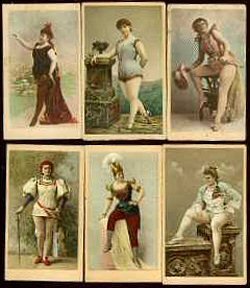 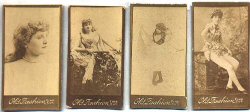 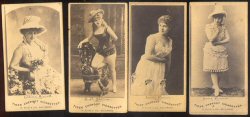 |
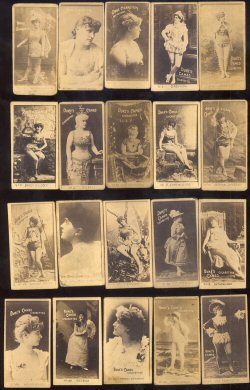 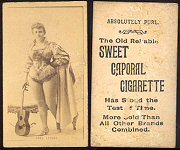 |
Actresses were hard to organize |
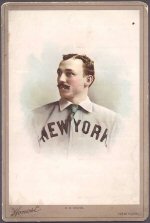 | N142 Honest Cabinets, G.S. Davis |
Burdickís Want List
In order to get my bearings again after thumbing through actresses, I asked the museum curator if they had a copy of Burdickís 1960 American Card Catalog. She had a copy behind her desk. The copy she handed me had many scribbled numbers in the margins. The curator said that she didnít know what the notations meant. I wondered who had scribbled in Burdickís book, which is itself a collectible. The scribbled numbers looked like they might mean the cards in a set like 50 or 25. The scribbles looked familiar. I had found a number of old letters from Jefferson Burdick in correspondence to Lionel Carter last year. Burdickís handwriting deteriorated as the arthritis that afflicted him in his later years increased. The scribbling was Burdickís. In fact the notated book amounted to Burdickís want list. He indicated how many cards he had in each set donated to the Museum and whether he had included any variations.
So what do you get for the collector who had everything? I looked at a few scarce and popular sets listed by Burdick in The American Card Catalog and his own notations as to how many cards he had collected and donated. The information is as follows:
|
|
Given the zeal in which Burdick pursued completing these early sets, it is noteworthy how scarce some of these sets are such as the T4s and Kalamazoo Bats. Burdick had just one card from the two sets.
Old Judge
Album 207 was followed by Albums 214 and 214A that held the mother lode of Old Judge cards. I have a type card or two of Old Judgeís. Like many of the surviving N172s, my cards were not only inserted in packs of cigarettes in the late 1880s, they were subsequently also sat on several times, flipped, chewed, and washed. The thick cardboard used for these small cards caused them to curl up. Mounting them neatly in scrapbook albums was a near impossible challenge for old-time collectors like Lionel Carter. The cards are about 2Ĺ inches high and 1Ĺ inch wide. However sizes and printings vary considerably as evident by paging through Burdickís collection. Burdickís N172s include $10,000 Kelly, Matt Kilroy in four poses, Jack Burdock with a colorized uniform, big wide white belts on the Chicago White Stockings, and an all-pink card of Tom Daley. The managers and some of the players are pictured in formal wear in some cases with top hat, tails, and cigar in hand (E. Williamson). Baseball pioneer and Philadelphia manager Harry Wright is there with huge whiskers, a $9,500 card. John Ward is pictured in a tux even though he is a shortstop for New York. His card lists at $3,500. Burdick had 1,912 of these Old Judgeís. The N172 "set" consists of about 522 players in a zillion or so poses and variations. Pose variations continue to be discovered 117 years after issue according to dealer David Levin who specializes in 19th Century cards. Commons run (at least) $600 each in near mint. The small size of the cards and the wear and tear make the images a bit more challenging to appreciate. The Old Judge Cabinets however are an entirely different matter.
Burdick categorizes these 3 ĺ by 5 ĺ premium cards on thick cardboard as (N)173s. Goodwin & Co. issued the cards between 1888 and 1889. N172 cards or coupons were sent in order to claim the N173 premiums and collectors would ask for specific players. Old Judge Cabinets were hard to sit on, flip, chew or wash. The photography is very clear and the poses really send you back in time. Players pictured on the small N172s are posed "in action" by having them stare at balls magically suspended in air. The larger and clearer N173s add a little humor in that the strings holding the balls are much more evident. The players are standing ready to catch or hit balls on strings. They stand in high-topped shoes on patterned tile floors with a partition or two behind them. There is an occasional drawn landscape background. The catchers in these poses seemed to be the only ones with gloves and they looked like winter gloves you would wear to go to the office. Sometimes they had a second glove without fingers on their throwing hand. Catcherís masks were also pretty basic and looked to be the playerís own creation - like a modified kitchen strainer. The SCD Catalog lists commons in near mint at $1,500. Burdick had 151 of these babies and they were in great condition (save for a little paste.) Some of the more interesting cards were:
The Old Judge Cabinets rated an A+ on my "wow-o-meter."
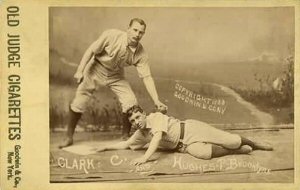 | Old Judge Cabinet of Clark tagging Hughes |
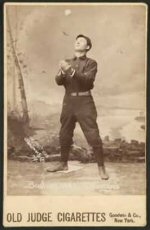 |
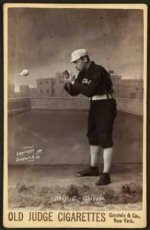 |
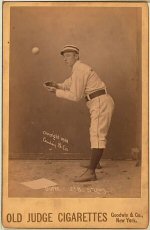 |
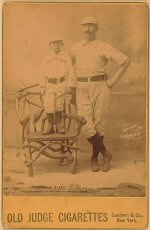 |
Charlie Bastian, Tom Daly, Charlie Duffe, Buck Ewing and mascot Willie Breslin |
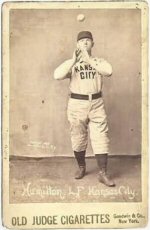 |
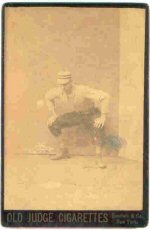 |
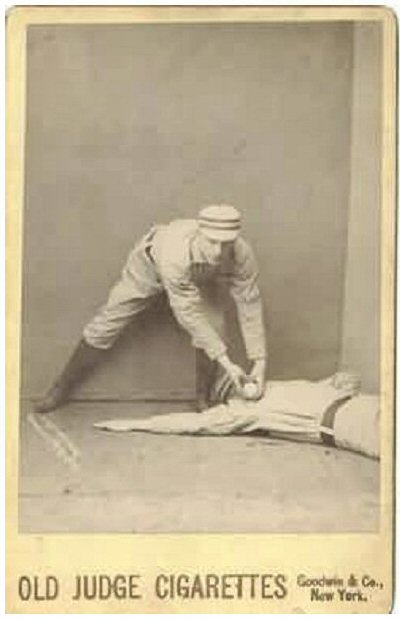 |
 |
Billy Hamilton, C. (as in Connie) Mack, Tommy McCarthy, and a rare N338-1 of Ebright |
Other Goodwin inserts N-162 through N171 are in this same album. The N162s are 50 Champions of various sports. Burdick arranges the set alphabetically by sport with the eight baseball cards together. Cap Anson ($6,000) is there along with King Kelly ($4,750), Tim Keefe ($4,500), Dan Brouthers ($4,500) and the rest of the gang. Burdick has all 50 of the N165 Games and Sport Series that include four baseball positions. He has all 50 N163 Dogs of the World and N166 Occupations for Women in burlesque-like poses.
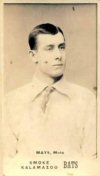 | 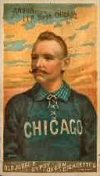 | N-690 Kalamazoo Bats of Al Mays and N-162 of Cap Anson |
The Million-Dollar Clock?
Moving to albums 215 and 215A I found more of the same Goodwin inserts with robust actresses, Morning Glory Maidens, Buffalo Bill, prizefighters and St. Louis Browns Champions. On the back of the N286 cards, a D. Buchner issue titled "Musical Instruments" (which were more about young ladies than musical instruments), there was information about a redemption program. You could send in from 100 to 600 insert cards and get a premium. The premium for sending in 400 cards was an umbrella. Six hundred cards got you a clock. The idea was to smoke 600 packs of these early non-filtered cigarettes, save the Old Judge cards of $10,000 Kelly and others, and ship them away for a clock that would keep track of the time for you before you succumbed to lung cancer. Iíll bet the clocks were subsequently destroyed by great-grandchildren upon learning that their forefathers had shipped off 600 19th Century tobacco inserts in PSA10 condition in exchange for a clock.
The rest of the album contained cards such as:
SF Hess N331 is at the back of the album and is described by Burdick as an "Art Series." I had read that the censors of the day were quite upset with the tobacco manufacturers for inserting "lewd" pictures of young ladies in cigarette packages. The ladies I had run across either had tights on or were well covered. The N331s are neither. Well, it is an art museum.
Bowmans
I skipped ahead 60 some years to Album #327 that contained Bowman baseball and football. Burdick had all of the early Bowmans. By lining up the 1950 Bowmans numerically on a page you noticed runs of players from the same team with the same backgrounds. Cards 100 through 102 are Yankees, 129 through 132 Cleveland Indians, and 201 through 203 are Pirates in front of evergreens. By 1953 the cards dwindle to a few representative samples. They were too new for Burdick. He had five 1953 Black & Whites and a few cards from 1954 and 1955. I found one 1950 football card that was placed in with the 1950 baseball cards. Since I had been bringing to the staffsí attention any loose cards on the pages, I thought I should let them know about this misfiling. I presumed the card had fallen out and been reinserted in the wrong spot. "That may be," they said but they werenít going to re-arrange anything in the albums that had been placed there (they thought) by Burdick. Their approach of keeping the collection intact and free from re-arrangements no matter how well intended was fine with me.
A Meeting with Jefferson Burdick
Although Burdick died just over 40 years ago, the only people I had been able to find that had ever met Burdick were veteran collector Lionel Carter and his wife Irma. They had visited with Burdick twice in the 1950s and had pleasant memories of exchanging information. Following this visit to the museum another collector contacted me with his recollections of Burdick. William MacKay was a serious teenage card collector when he visited the museum with his father to see the Burdick collection in the late 1950s. MacKay went to the study room, as I had, and asked to see the albums. The curator was able to do even better. She introduced MacKay to Jefferson Burdick who was there mounting cards in albums. MacKay reports: "An elderly man appeared; tall, but spent by age; slender; and mentally alert. I still remember that he had slender hands which he moved nervously. He said he had arthritis, but I remember being struck by his carefulness and rapid handling of his cards. He greeted us with the courtesy that one associates with a past century, even shaking my hand! He was very gentle and very inquisitive and asked me in what cards I was most interested. I think I said that whatever he was working on would be a delight. He returned with several large catalogs, mostly of nineteenth century actress photograph issues. My father helped me turn the pages of one catalog as Burdick worked with another; searching through its pages as he compared new cards with those already in the album for variants and contrast. At some point, he brought out some old baseball tobacco cards and we chatted about collecting. He was authentically interested in what issues I liked most and where I sourced my cards. He seemed pleased that I knew some of the numbers that he had assigned tobacco card sets. If he was impatient for us to leave it, I never detected it and my father, too, seemed convinced of the sincerity of his enthusiasm and interest. The collection, of course, was astonishing, although I saw only a miniscule fraction of it.
His interest was clearly in the cards, not in the baseball stars or celebrities they portrayed. If he had a personal preference, it seemed to be for the relatively uncharted nineteenth century sets. In his view collectors were researchers and appreciators, not speculators or celebrity hunters. In retrospect, I think that he wanted the collecting scene to resemble that of British cigarette cards collectors. I remember that Mr. Burdick was jovially emphatic about how much the act of cataloguing his cards had taught him. To this day, when I'm doing research projects [I'm an editor and writer], I think of the wisdom of those remarks." Thanks to Bill MacKay of New York City for sharing those recollections. I would have liked to have been there with him.
Observations
Going through 10 albums on this visit and 7 on the prior visit out of 394 albums in the collection had left me blurry-eyed. It was like going to a 1,000 table National Convention with no money and 2Ĺ hours available. But I enjoyed every minute. Iíve now probably seen 12,000 cards of the 306,000-card collection. I wished I had known more about some of the rare sets from the 19th Century that Burdick had so painstakingly assembled. I had developed a much greater affinity for the early tobacco cards even if it had only been an afternoon visit and I had "discovered" Burdickís want list. Finally another collector who had met Burdick had contacted me.
On the positive side the collection is still in the same arrangement it was over 40 years ago when Burdick placed the last card in the last album. On the negative side, it is still in the same arrangement. The scrapbooks dry out and crack. The paste holding the cards dries out. The cards come loose. Pages are turned and can be bent. The cards on the pages can bend with the pages. Some cards are hinged with tape so that the backs can be viewed. When the pages are turned the cards can flip and get dings. Fingers are greasy and the pages can get soiled. Many of the cards are incredibly rare and valuable. Someone has to be present while any of the collection is examined.
Burdick wrote in his June 1948 Card Collectorís Bulletin that he had consulted with the museum regarding methods for mounting his cards. Museum curator A. Hyatt Mayor insisted "that the materials used must be such as to last at least a hundred years...(giving) an idea of the permanency of museums and the way they look at things." In the same issue Burdick reiterated that the collection would "be a National collection belonging to everybody." The materials used donít look like they will serve the collection if heavy usage were to continue for a hundred years. In order for "everybody" to view the collection it would have to be completely rearranged in a secure, encased, protected environment bolted to granite. I donít see it happening without significant funding, although a page or two out of certain albums could probably pay for a host of improvements. Then there is the no small matter of providing space to exhibit more of the collection. Museums have huge collections that cannot all be afforded public display space particularly in such a premium environment as the Metropolitan Museum of Art. Tucked away in the print room where Burdick left it, in the same books he used, may have to suffice for now for the Burdick Collection.
Photo credits: Wayne Delia for the baseball cards, David Levine for the actresses. Cards depicted are not the actual cards in the Burdick Collection.
George Vrechek can be contacted at vrechek@ameritech.net
O B C : A T r a d i t i o n o f E x c e l l e n c e S i n c e 1 9 9 1
Old Baseball Cards (OBC), copyright© 1991 - by OBC.
Unauthorized use of the material contained on this page is strictly prohibited.
This page was last updated on